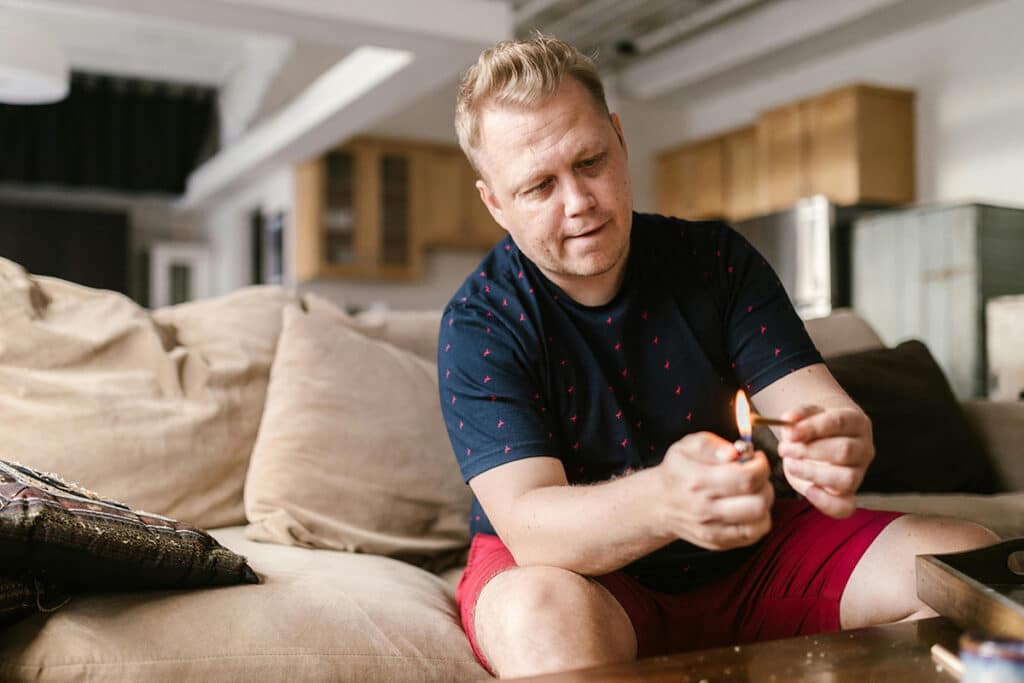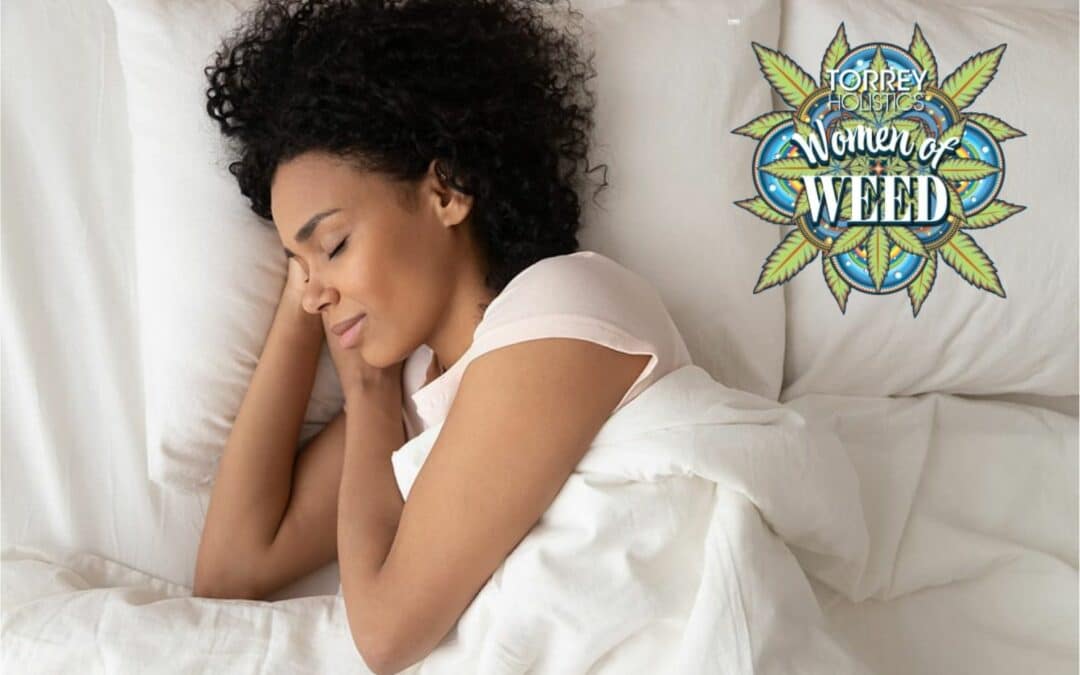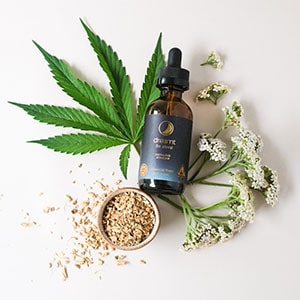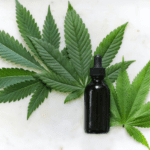Guest post by Carolina Vasquez Mitchell, MS
Using Cannabis as a Sleep Aid: Can Marijuana Help you Fall Asleep and Stay Asleep?
If you are one of the roughly 100 million Americans that reports having regular sleep-related issues, then you’ll know the quiet agony of laying awake at night, tossing and turning, desperate for just a few hours sleep. Getting quality sleep every night can seem like an impossible dream for those of us trapped in this battle.
Chronic sleep problems can be hugely debilitating to our mental and physical health and can dramatically reduce our quality of life. From an increased risk of heart failure and unnecessary weight gain, to making us more prone to depression and anxiety, sleeplessness is one of the most widely held yet under-acknowledged public health problems today.

Cannabis is one of America’s most popular means of getting to sleep. As many as 74% of cannabis consumers report using it in part to help them sleep [1]. Whether you’re picking up an indica strain, a strain with lots of myrcene and linalool (a pair of sleep-inducing aromatic compounds, otherwise known as terpenes, which we will explain in more depth later), or something specifically formulated for sleep, there is a vast amount of potential to alleviate sleep-related issues with this incredible plant.
In this article in collaboration with Torrey Holistics, we break down how cannabinoids, terpenes and other compounds actually help you sleep, clear up a few myths, and explain why I developed my product dreamt, which is the first science-backed cannabis sleep aid that truly works.
Meet the Author, Scientist, Cannabis Product Developer, and Lifelong Insomniac

Carolina Vazquez Mitchell, MS
My name is Carolina Vazquez Mitchell. I’m a Mexican scientist, cannabis product developer, and the founder of dreamt. I have been struggling with insomnia for most of my adult life. The years during my PhD studies in chemistry at USC were particularly challenging. The workload, the stress, adapting to this strange new country, all of it was having a negative impact on my precious sleep. Like many health-conscious people, I didn’t want to take pharmaceuticals, and so I was curious when my research into natural sleep aids led me to cannabis.
During this time I tried every type of cannabis product on the market, but nothing worked. I found flower unpredictable and harsh on my lungs and many of the sleep-related claims made by brands on the market at that time weren’t consistent with the science.
I started developing a formula that was supported by the existing scientific research. This formula would harness the incredible sleep-inducing properties of cannabis but combine it with compounds like melatonin and valerian root to improve its effectiveness at putting you to sleep and keeping you out for a full night, as well as compensating for the reduction in REM Sleep, which cannabis use can inhibit.
Our formula, which I first developed for a vaporizer, worked wonders for me and for those we shared it with. From there, we started building the dreamt brand, and I worked to adjust the formula to fit a variety of delivery methods (tincture, beverage and a gummy), giving people options in how they consume our products and improve their quality of life.
How do THC and CBD Help You Fall Asleep and Stay Asleep Longer?
There is an extensive body of scientific literature that shows cannabis’ sleep-inducing qualities. These studies found that cannabis flower significantly improved users’ perceived insomnia [2], and that THC generally reduced sleep onset latency and enhanced slow wave sleep (a.k.a deep sleep) [3]. While the exact mechanism of this is not fully understood, THC binds to and strongly activates the body’s CB1 receptor and activation of this receptor induces sleep [4,12]. Interestingly, researchers showed that CBD had dose-dependent effects on sleep and at low doses (like those often found in CBD products) was found to be wake promoting [3]. But the simultaneous administration of THC and CBD reduces the psychoactive effects while increasing the intensity and duration of THC’s natural sedating effects [5,6].
To summarize, THC is very effective at inducing sleep, but there is the risk of unwanted side effects (anxiety, paranoia, overactive brain etc.). When combined with CBD in a specific ratio (our research indicates that the optimal ratio is 2.5:1 THC to CBD), the risk of undesired side effects are diminished while the sleep inducing effects of THC are enhanced [13]. Cannabinoids have been shown to improve deep sleep, but reduce the time spent in REM sleep, which is hugely important for your cognitive development and for forming memories.
These cannabinoids, while effective, only get us part of the way towards a healthy night sleep. It’s when we combine these cannabinoids with other molecules that we can see the plant’s potential as a sleep aid truly unleashed.
What are the Best Cannabis Terpenes for Sleep?
Terpenes play an important role in giving cannabis its personality. They are the main components of essential oils, and are found naturally in a wide variety of plants. They are volatile aromatic molecules that give cannabis its distinctive fragrance, its particular psychoactive character and boost the effects of cannabinoids (a phenomenon widely dubbed The Entourage Effect) [14] . Terpenes have pharmacological significance and have been used therapeutically throughout history. They are typically added to enhance the health benefits of many products either alone or synergistically.
As education levels across the industry have improved, people are looking at terpene profiles to get a more accurate read on a strain’s character, and whether it can be used effectively to address specific ailments. When it comes to sleep, terpenes such as myrcene, linalool, and limonene—all of which are present in dreamt’s formula—have been shown to have relaxing and/or sedating properties, whereas terpenes like pinene or geraniol have been shown to boost mood and energy [9].
Does CBN Help you Fall Asleep?
One cannabinoid that is getting a lot of hype at the moment for its reported sedative qualities is cannabinol, or CBN. When I am in dispensaries talking about dreamt with budtenders and consumers, I am often asked, “Does dreamt contain CBN?”.
No it doesn’t. And here’s why.
CBN is a product of degraded THC which produces similar but much weaker effects (and possibly no psychoactive effects at all). The effects are so weak that researchers still debate whether CBN is a weaker version of THC or if it has any sleep effects at all. A reason for this lack of activity could be the fact that CBN interacts very weakly with your endocannabinoid system’s CB1 receptor (found mostly in your brain) and therefore it fails to have significant effects on sleep, pain relief, or relaxation. However, studies have also shown that CBN interacts strongly with CB2 receptors (found mainly in the body and barely at all in the brain), and this indicates a possible impact on the immune system.
I wrote an in-depth article on CBN’s dubious reputation as a sleep aid for leading cannabis magazine mg. You can read the full article here if you want to learn more about CBN and the science behind it.
dreamt – A Cannabis Product Designed to Help You Sleep!
dreamt is the first science-backed cannabis sleep aid on the market. Our vape pen and tincture formulas contain a precise blend of THC (5mg per dose), CBD (2mg per dose), melatonin, valerian root and terpenes, and are designed to help you fall asleep quickly and enjoy a full night’s rest.
Since launching in December 2019, dreamt has been featured in Rolling Stone, Business Insider, and Vice, who dubbed our products “one of the year’s most helpful innovations”. We also won Best New Product at Weedcon 2020, and have created more than 1.4 million nights of sleep for Californians at a time when sleeplessness is on the rise and its health implications (weakened immune system, increased risk of heart disease, depression) are made more serious by the spread of COVID-19.
These statements have not been evaluated by the FDA. Nothing said, done, typed, printed or reproduced by Torrey Holistics is intended to diagnose, prescribe, treat or take the place of a licensed physician.
About the Author

References
1. Bachhuber, M., Arnsten, J. H., & Wurm, G. (2019). Use of cannabis to relieve pain and promote sleep by customers at an adult use dispensary. Journal of psychoactive drugs.
2. Vigil, J., Stith, S., Diviant, J., Brockelman, F., Keeling, K., & Hall, B. (2018). Effectiveness of raw, natural medical Cannabis flower for treating insomnia under naturalistic conditions. Medicines, 5(3), 75.
3. Babson, K. A., Sottile, J., & Morabito, D. (2017). Cannabis, cannabinoids, and sleep: a review of the literature. Current psychiatry reports, 19(4), 23.
4. Murillo-Rodríguez, E. (2008). The role of the CB1 receptor in the regulation of sleep. Progress in Neuro-Psychopharmacology and Biological Psychiatry, 32(6), 1420-1427.
5. Nicholson, A. N., Turner, C., Stone, B. M., & Robson, P. J. (2004). Effect of Δ-9-
tetrahydrocannabinol and cannabidiol on nocturnal sleep and early-morning behavior in young adults. Journal of clinical psychopharmacology, 24(3), 305-313.
6. Hollister, L. E., & Gillespie, H. (1975). Interactions in man of delta‐9‐tetrahydrocannabinol; II. Cannabinol and cannabidiol. Clinical Pharmacology & Therapeutics, 18(1), 80-83.
7. Russo, E., & Guy, G. W. (2006). A tale of two cannabinoids: the therapeutic rationale for combining tetrahydrocannabinol and cannabidiol. Medical hypotheses, 66(2), 234-246.
8. Lucas, C. J., Galettis, P., & Schneider, J. (2018). The pharmacokinetics and the
pharmacodynamics of cannabinoids. British journal of clinical pharmacology, 84(11), 2477-2482.
9. Do Vale, T. G., Furtado, E. C., Santos Jr, J. G., & Viana, G. S. B. (2002). Central effects of citral, myrcene and limonene, constituents of essential oil chemotypes from Lippia alba (Mill.) NE Brown. Phytomedicine, 9(8), 709-714.
10. Pertwee, R. G. (2006). Cannabinoid pharmacology: the first 66 years. British journal of pharmacology, 147(S1), S163-S171.
11. Karniol, I. G., Shirakawa, I., Takahashi, R. N., Knobel, E., & Musty, R. E. (1975). Effects of Δ9-tetrahydrocannabinol and cannabinol in man. Pharmacology, 13(6), 502-512.
12. Murillo-Rodríguez E. The role of the CB1 receptor in the regulation of sleep. Prog Neuropsychopharmacol Biol Psychiatry. 2008;32(6):1420-1427.
13. Solowij N, Broyd S, Greenwood LM, et al. A randomised controlled trial of vaporised Δ9-tetrahydrocannabinol and cannabidiol alone and in combination in frequent and infrequent cannabis users: acute intoxication effects. Eur Arch Psychiatry Clin Neurosci. 2019;269(1):17-35.
14. Russo, E.B. (2011). Taming THC: Potential cannabis synergy and phytocannabinoid‐terpenoid entourage effects. British Journal of Pharmacology, 163, 1344–1364.





